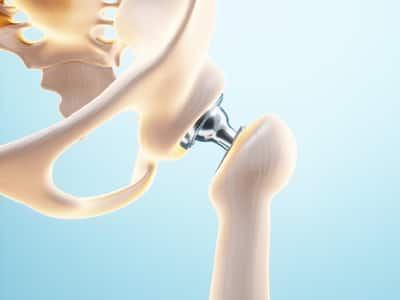
Doctors sometimes recommend a hypersensitivity test before an implant is chosen for joint replacement surgery or arthroplasty to prevent metal hypersensitivity in patients.
Joint replacement surgery or arthroplasty is a surgical procedure used to replace damaged joints (usually in the hip, knee or shoulder) with artificial implants. These implants are usually made of metal alloys, strong plastic and ceramic material. Many patients experience metal hypersensitivity or metal allergy after arthroplasty. Read on to causes, symptoms and treatment of metal hypersensitivity after joint replacement surgery.
Dr CS Yadav, Head of the Department of Orthopaedics and Joint Replacement, Primus Super Speciality Hospital, New Delhi, says, “Metal sensitivity is usually found higher in patients with knee arthroplasty. Hence, patients who have a history of metal allergy must be thoroughly examined through both dermatological and laboratory testing before undergoing the surgery. Currently, a patch test is the most common method used to determine metal hypersensitivity or reactions, though it comes with its own limitations.”
Dr Yadav tells us more about joint replacement surgery, and who are at higher risk of metal hypersensitivity. Excerpts follow:
Osteoarthritis and knee replacement
Octogenarians or older people mostly suffer from the degenerative disorder of osteoarthritis, which occurs more with age and increased obesity. The etiology of osteoarthritis entails a multifactorial interplay of mechanical and biological causes. As a coping mechanism, surgical therapy is required in cases of advanced osteoarthritis.
Several factors lead to the degeneration of joints. In degenerative joint diseases, there is a loss of the cartilage or cushion in the joints and thus arthroplasty is prescribed. Osteoarthritis is one of the common reasons for arthroplasty.
What is arthroplasty? It is a surgical procedure to restore the function of a joint performed by resurfacing the bones. An artificial joint called a prosthesis may also be used. Total knee arthroplasty provides extremely beneficial results, however, around 20 per cent of the cases might bear unsatisfactory results. One of the causes of unsatisfaction is metal hypersensitivity.
Research shows that 10 to 15 per cent of the patients present dermatologic symptoms caused by metal hypersensitivity after knee replacement. Nickel is responsible in the majority of cases, while cobalt, chromium, beryllium, tantalum, titanium, and vanadium are responsible for dermal symptomatology.
Symptoms of metal allergy after joint replacement
Symptoms of a reaction to metal implants can range from pain and cutaneous dermatitis to aseptic loosening of the arthroplasty. While cutaneous and systemic hypersensitivity reactions to metals have increased concern after joint arthroplasties, allergies against implant materials are still quite rare and do not count as a major cause of failure.
READ RELATED: 12 Best High-Protein Vegetables
Symptoms like rashes, swelling, or pain due to contact with certain metals can also be witnessed in cases of metal hypersensitivity and allergy. Apart from the topical reactions, metal hypersensitivity can also result in chronic conditions such as fibromyalgia and chronic fatigue syndrome.
Causes of metal allergy and potential complications
Whenever the immune system of a host body starts targeting foreign metal ions as threats it results in metal hypersensitivity. Normally, the cells kill foreign bacteria and viruses by causing inflammation. When the same cells start attacking metal ions that are implanted in you, metal hypersensitivity symptoms start showing up.
Metal allergies are very common in everyday life. Watches, coins, and jewellery usually act as metal allergy triggers. As stated earlier, nickel is one of the most frequent allergens, causing major dermatitis. Cobalt, copper, and chromium are also very common triggers. Medical devices also contain possible allergens such as chromium and titanium. A few implantable devices such as artificial knees, artificial hips, pacemakers, stents, fracture plates, rods, or pins may contain metals that can cause metal hypersensitivity reactions. The reactions become graver with time when the metal is implanted in the body for a longer period of time. In addition, people who already have an autoimmune disorder can have a higher risk of metal hypersensitivity.
Apart from the aforementioned complications, these are the following conditions linked to metal hypersensitivity:
- chronic fatigue syndrome
- eczema
- fibromyalgia
- osteomyelitis
- rheumatoid arthritis
Treatmentof metal hypersensitivity
Treatment of metal hypersensitivity is largely individualised. The treatment process depends upon the allergens and their reactions. Topical dermatitis metal sensitivity can be resolved by avoiding the metals that cause the reaction. Application of corticosteroid creams and ointments can be prescribed to reduce allergy reactions.
However, reactions caused by implants are more difficult to resolve. For example, if the allergy is caused by an artificial knee or hip, treatment usually involves both topical and oral medications. Due to the difficult nature of treating systemic metal allergies, doctors sometimes recommend a hypersensitivity test before an implant is chosen. Awareness and prevention remain key factors. Ask your doctor and share your concerns honestly to adjudge the best possible treatment for you.
Newer prosthetics with reduced risk of metal allergy
Newer prosthetics and implants are being developed with the aim of minimizing the risk of metal allergies. For example, some manufacturers are using materials such as zirconium, ceramic, and polyethylene to create implants that are less likely to trigger an allergic response. Additionally, some implants are coated with materials that are less likely to cause an allergic reaction, such as hydroxyapatite or diamond-like carbon. These new approaches to prosthetics and implants are providing patients with more options and reducing the risk of adverse reactions.
Total Wellness is now just a click away.
Follow us on
window.addEventListener(‘load’, (event) => {
// $(document).ready(function(){
$(‘#commentbtn’).on(“click”,function(){
(function(d, s, id) { var js, fjs = d.getElementsByTagName(s)[0]; if (d.getElementById(id)) return; js = d.createElement(s); js.id = id; js.src = “//connect.facebook.net/en_US/sdk.js#xfbml=1&version=v2.3”; fjs.parentNode.insertBefore(js, fjs);}(document, ‘script’, ‘facebook-jssdk’));
$(“.cmntbox”).toggle();
});
// });
});







